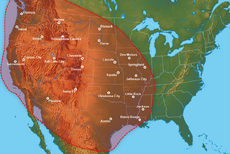![]() This Yellowstone: 1936 related article is a stub. Please add suggestions on the talk page.
This Yellowstone: 1936 related article is a stub. Please add suggestions on the talk page.
| 1936 Yellowstone Eruption | |
|---|---|
| The volcanic ashfall region in the United States where ash reached a thickness of 1 cm | |
| Volcano | Yellowstone Caldera |
| Date | July 18, 1936 |
| Type | Ultra Plinian |
| Location | Yellowstone National Park, Wyoming |
| VEI | 8.5 |
| Impact | Plunged Earth into a twelve year volcanic winter, led to failed harvests and famine worldwide |
The 1936 Yellowstone Eruption, also known as the Yellowstone Event or Eruption Day, was a supervolcanic eruption that occured on the morning of July 18, 1936 at the site of the Yellowstone National Park. It has been considered the largest eruption in recorded history, and perhaps the largest volanic eruption in history. Tens of thousands died over the first number of days following the eruption, and the ash deposited in the atmosphere led to a worldwide volcanic winter lasting for twelve years (with cooling effects lasting well beyond then), as well as mass crop failure and famine, which furthered the death toll into the hundreds of millions; the most deadly natural disaster in human history.
Since it's eruption seventy-seven years ago, it has been a major watershed moment for the human species, with most governments worldwide still suffering the effects of the volcano (such as the failure of crop growth worldwide due to the cooling of Earth's temperature), and economic, technological and social growth being retarded due to the collapse of many governments in the subsequent years/decades following the eruption.
Build-up to the eruption
Prior to the 1936 eruption, the Yellowstone caldera had remained dormant for almost 640,000 years, when the Lava Creek eruption took place; whilst other eruptions are believed to have occured 2.1 million and 1.3 million years ago. The minor tremors began in early June, leading some scientists working at the national park to believe that extensive magma activity was occurring beneath ground level. Over the next month, especially in the days leading up to the eruption, the ground in the park appeared to be moving up-and-down at a pace faster than it has normally done in the past. Shocks of magnitude of 2.5 were recorded in the lead up to July, and further minor tremors on a magnitude of 3 and above were recorded in the final days before the eruption.
Diagram of the Yellowstone caldera prior to the eruption
Between the 10 July and the 13 July, over 500 minor shocks were recorded in the Yellowstone area, the magnitude of the strongest being 5.1. After July 6, the park was closed down after a major tremor struck the north of the park, with a foul smelling sulphur scent being detected after that date. Scientists began to clamber for those in the immediate area to leave until the tremors ended, some believing a eruption was due in two to three months time. During the last week prior to the eruption, thousands of tremors were detected beneath the Yellowstone park area, with a rise in geyser activity due to the underground magma heating the groundwater systems, and dozens of phreatic eruptions (steam driven eruptions) being noted prior to 18 July.
By this time, many people living close to the national park were beginning to flee or had already fled, with many professionals declaring the area within 50 km (31 miles) out of bounds. On the night of the 17 July, many scientists and officials still working in the area noted that small granitic magma flows were spotted in the extreme north regions of the Yellowstone park, and most were fearing that an eruption would come within the fortnight to at least three months (allowing most civilians to leave the area), but the final overnight tremors and the extensive land movement would prove them wrong the following morning.
| ||||||||||||||||||||

